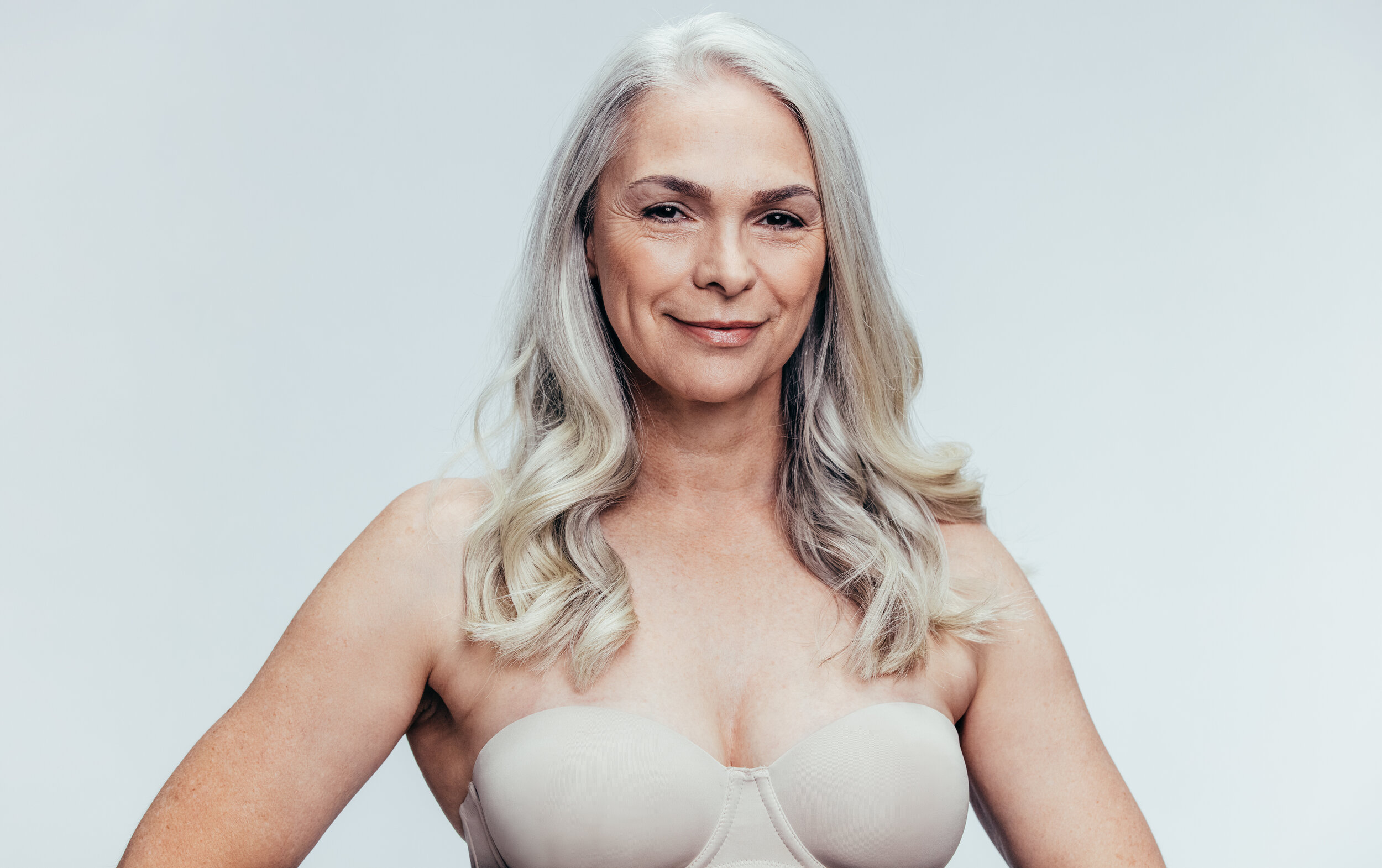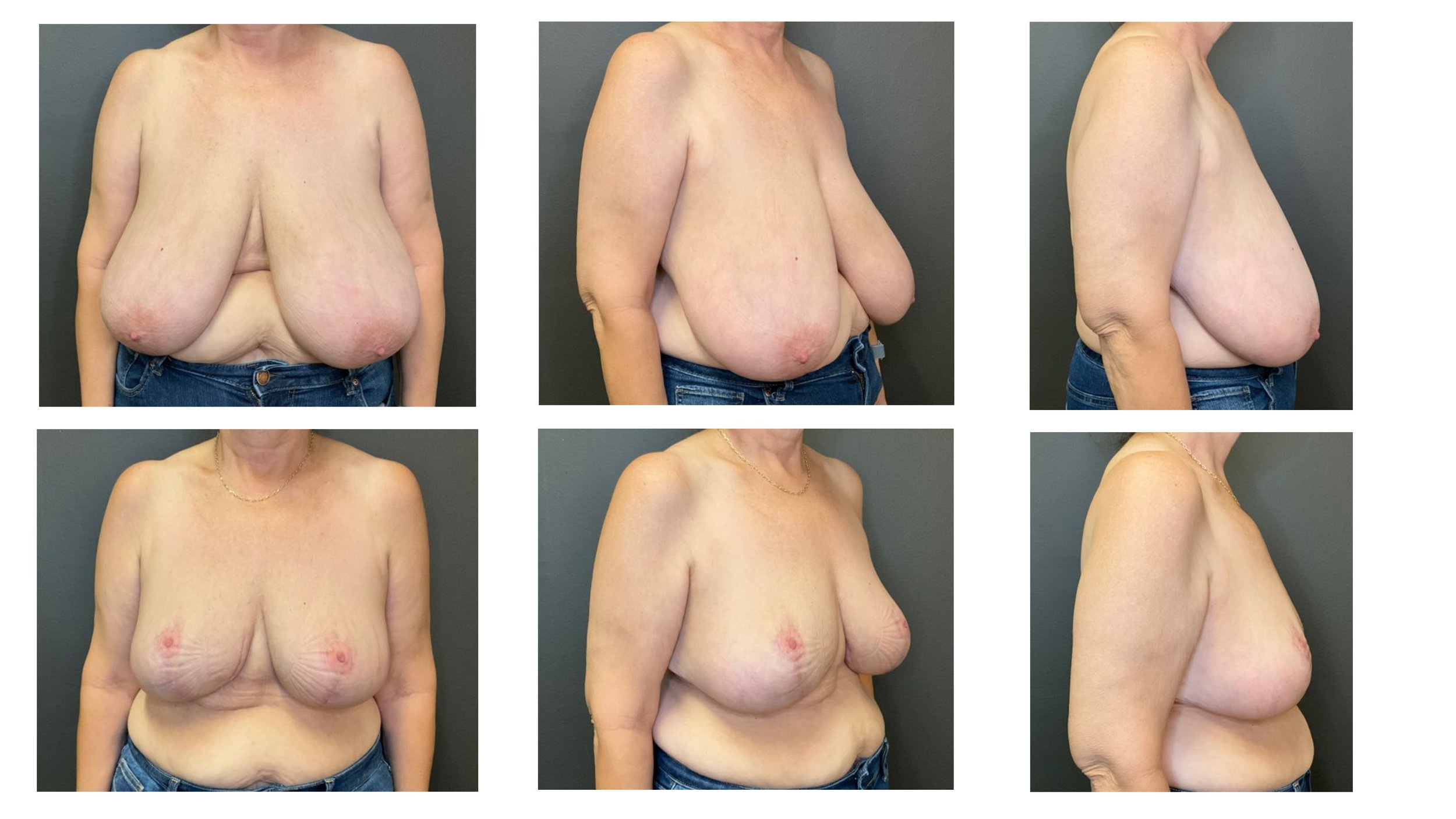Breast Services
Reconstruction
If you have been diagnosed with breast cancer know that there are a number of reconstructive options available to you. Dr. Chiasson will explain these options to you, listen carefully to your questions and concerns, and work closely with your breast surgeon to create a reconstructive plan specifically for you.
Oncoplastic Reconstruction
Oncoplastics is a term that encompasses many different reconstructive procedures that may be utilized to correct the defect created from a partial mastectomy or lumpectomy. This involves preserving most of your own breast tissue and is also known as breast conservation therapy. Women who chose to conserve their own breast (instead of a mastectomy) will need radiation after their cancer has been resected, but they may benefit from oncoplastic reconstruction. This involves rearranging local tissue from the breast or chest in a way that helps re-create your native breast shape and size. It may also involve a procedure on your non-cancerous breast for symmetry, such as a breast lift or reduction. Dr. Chiasson and your breast oncologic surgeon will consult with you to determine if you are a good candidate for oncoplastic surgery.
Direct to Implant
For some women undergoing a mastectomy, placing a breast implant during the same surgery may be an option. This technique is best suited for women with small to moderate-sized breasts who will not need radiation after the mastectomy. The breast implant is typically placed on top of your pectoralis muscle and may be wrapped in a material called acellular dermal matrix for soft tissue support. Sometimes this procedure is combined with autologous fat grafting in a second surgery. Consultation with Dr. Chiasson and your breast oncologic surgeon will help determine if this is an option for you.
Tissue Expander and Implant Breast Reconstruction
The most common method of post-mastectomy breast reconstruction in the United States is a two-staged procedure. At the time of the mastectomy, a tissue expander is placed. It is usually wrapped in a material called acellular dermal matrix. Over the next few months, the expander is filled with saline. The saline addition is done in the office and is quick and painless. After the desired size has been reached a second surgery is done in which the expander is removed and a final permanent implant is placed. The final implant is silicone gel. Fat grafting may also be done to enhance the overall result if needed.
Latismus Flap
The breast may be reconstructed by transferring skin and muscle (the latisimus dorsi) from the back. The latisimus is a large, flat muscle that provides excellent coverage of an implant. It is a good choice if the mastectomy skin flaps may not be healthy such as in patients who smoke or who have had prior chest wall radiation. The back scar can be placed in the bra line and the loss of the muscle does not result in a physical deficit.
DIEP or TRAM Flap
The TRAM (transverse rectus abdominus musculocutaneous) flap uses tissue from the lower abdomen to reconstruct the breast. The DIEP (deep inferior epigastric) flap also uses abdominal tissue that is transferred to the chest wall as a free flap. It is a complex operation but one that can create a breast with your own tissue, usually avoiding the need for an implant.

Augmentation
Breast enhancement, also known as breast augmentation, is the #1 plastic surgery procedure performed in the United States. For many women, small breasts cause feelings of self-consciousness or create problems wearing certain clothes or swimsuits. For other women, loss of breast volume may occur after breastfeeding, weight loss, or just the passage of time.
Breast augmentation offers you the opportunity to transform your breast size and shape using breast implants. Dr. Chiasson will assist you in making a truly informed decision. She will listen carefully to your desires and together you will select the best size and style implant to achieve your goals. The size and type of the most suitable implant depends on many factors unique to you: desired size, anatomy, skin quality, and body type. You have choices in incision placement. The implant may be placed over or under the chest wall muscle. Dr. Chiasson will thoroughly discuss the pros and cons of these options with you.
Choosing an ideal breast size is a highly personal decision. Your ideal breast size may be different. Dr. Chiasson will never over-augment you such that you have long-term issues related to excessively large implants. While implants are not “forever” devices the fewer breast implant surgeries you have during your lifetime, the better.
The surgery is performed under General Anesthesia in an out-patient setting. Plan to take a few days off of work or household duties before resuming modified activity.





Breast Lift
Breast lift, also known as mastopexy, is a surgical procedure designed to elevate and reshape sagging breasts and reposition the nipples to a more pleasing location. A number of conditions can cause your breasts to sag: pregnancy and breastfeeding, weight loss, or the natural aging process affecting the skin and breast glandular tissue.
Dr. Chiasson will carefully listen to your desired outcome and expectations and assist you in selecting the best approach to help you achieve your goals. If you desire an increase in breast size a gel implant can be placed at the time of the lift. As the implant increases the weight of the breast it is wise to avoid overly large implants. Also, should you desire a reduction in the size of your areola (the darker pigmented skin around the nipple), this can easily be addressed with the lift.
Ptosis (sagging) of the breast is graded in severity by the relationship between the location of the nipple relative to the inframammary fold (the crease below the breast). The degree of ptosis along with your desired outcome will determine the appropriate surgical choice. Minor lifting results in fewer incisions. If you have more severe sagging with the nipple falling below the fold longer incisions are necessary and will lead to longer scars. You will be instructed on how to care for your incisions and scars so that an optimal result can be achieved.
Breast lift is out-patient surgery performed under general anesthesia. The recovery time is relatively quick and you will be back to full activity in a few weeks.


Revisional Breast Surgery
You had your breast augmentation surgery years-decades-ago. Over time, your body has changed. Your lifestyle has changed. Your interests have changed. Maybe the implants you loved long ago don’t please you any longer. You think they are too big/too saggy/too firm. What to do?
With over 40 years of combined experience in all types of breast surgery, the Board-certified mother daughter duo at FORD Plastic and Reconstructive Surgery can solve whatever problems your old implants are giving you!. Dr. Katherine Ford Chiasson and Dr. Ann Ford Reilley have the surgical skills and experience to deliver the result you desire.
You will feel very comfortable sharing your unique goals with Dr. Kate. Together you will discuss your options and customize a surgical treatment plan. Aesthetic and functional goals vary from patient to patient. Breast revision surgery can include any of the following, depending on your tissue quality and goals:
Explantation (implant removal)
Explantation plus Mastopexy (breast lift)
Explantation + Autologous Fat Grafting (AFG)
Explantation + Mastopexy + AFG
Implant Exchange (change of implant size or type)
Mastopexy + Implant Exchange + Soft Tissue Support (“ internal bra”)
Mastopexy + Implant Exchange + AFG
Some patients will require surgical treatment of the “capsule” or scar tissue surrounding the implant. Options include capsule removal or modification (capsulotomy or capsulorraphy). Patients with saline implants may undergo pre-operative implant deflation. This is a quick in office procedure. Pre-operative implant deflation allows the “skin brassiere” to shrink and gives us a better idea of actual breast volume as well. It results in greater accuracy in executing the surgical plan. Cost and recovery time will depend upon the plan selected. All the surgical options are outpatient procedures performed under general anesthesia.
Revisional breast surgery is performed under general anesthesia as an outpatient. Particularly complex cases are done in two stages. Recovery times vary depending upon the selected treatment plan.
Ready to make a change? Call the breast surgery experts at FORD Plastic and Reconstructive Surgery.

Breast Reduction
Breast reduction surgery is done to decrease the size and weight of oversized breasts. Excessive breast size can create problems that not only affect how you look but also how you live your day-to-day life. Younger patients may experience unwanted attention or difficulty participating in sports as well as problems with clothing selection. Older women experience increasing back, neck, and shoulder pain as well as difficulty enjoying an active lifestyle. Most believe that their large breasts make them appear older and heavier. If you live with breast hypertrophy for many decades you may exhibit shoulder grooves, poor posture, rashes, and discomfort with yearly mammograms.
Breast reduction (or reduction mammoplasty) involves the removal of excess breast tissue and breast fat to reshape, resize, and lift the breasts. It significantly improves the quality of life for women of all ages. The issues that bother you can be resolved in a 2-3 hour, outpatient operation under general anesthesia. Dr. Chiasson will discuss the various surgical options with you. Virtually all breast reductions will preserve the nipple–areolar complex on underlying breast tissue (the pedicle). This allows for the possibility of breastfeeding in the future for those so inclined. All breast reduction techniques will leave permanent scars on the breasts. Your genetics are the primary determinant of your scar quality.
Your insurance may or may not cover the cost of surgery. Pre-certification is often required for reimbursement or coverage. Many patients elect private payment so as to have control of the amount of tissue removed and their final size.





Gynecomastia
Are ”man boobs” keeping you from taking of your shirt at the pool or the beach? At FORD Plastic and Reconstructive Surgery we have the surgical skills and empathy to treat this sensitive issue.
Gynecomastia is the medical term for overdeveloped or enlarged male breasts. This condition affects at least 40% of the male population. It may start in adolescence or begin later. Gynecomastia is characterized by excess breast glandular tissue, excess breast skin, and/or excess fatty tissue. The condition is typically bilateral (both breasts).
Some causes of gynecomastia include medications, steroids, marijuana, androgen (male hormone) deficiency, testicular tumors, excess weight, liver disease and kidney disease.
Surgical treatment may or may not be covered by insurance. Any potential causes should be eliminated. Patients undergoing surgical treatment should be in good health, willing to eliminate causative agents and follow instructions for post-operative care.
Surgery is performed under general anesthesia as an outpatient. In most cases Dr. Chiasson will use an incision at the lower areola to remove excess breast tissue and suction fat. In more severe cases excess skin is removed leaving longer scars place in normal skin folds. Sometimes a drain is used for a few days. A compression vest is worn for several weeks.
The goal of gynecomastia surgery is self-confidence and improved quality of life.
Breast Implant Removal (Explant)
Breast implant removal surgery or explantation removes the implants (saline or gel) and some, all, or none of the tissue (capsule) around the implant.
Implants may be removed for personal or medical reasons. Implants are not lifetime devices. Gel implants that leak or rupture may cause the body to form a thicker capsule around the implant. In severe cases, this thick capsule will distort the shape of the breast or cause unnatural firmness or even pain.
Treatment options are varied and will be determined by your goals, your physical exam, and findings on mammogram and ultrasound. Your unique situation calls for an individualized approach and Dr. Chiasson will help you decide which option is best for you. You may decide to remove your implants permanently. You may decide to replace them with implants of a different size. You may desire a reshaping and lift of your breasts.
If your implants were placed for cosmetic reasons, the implant removal surgery will also be considered cosmetic. If your implant surgery was for breast reconstruction the removal surgery will likely be covered by your insurance. The surgery is performed under General Anesthesia. You will return home after surgery and the recovery time is relatively brief.

Breast Asymmetry
Unequal or asymmetrical breast size occurs more frequently than you might expect. While mild variations in size or shape are common and require no treatment, more noticeable differences may cause you difficulty in selecting clothing and swimwear, or if more extreme, may be a cause of psychological distress.
There are a number of factors that might make your breasts uneven. Heredity and hormones may play a role. Often there is no known cause.
When should you consider surgical correction and when is the best time for you to undergo corrective surgery? Certainly, if this condition is negatively affecting your self-esteem, strong consideration should be given to discussing your situation with a compassionate plastic surgeon. If the asymmetry is less severe, a watchful waiting approach may be appropriate to delay the surgery until breast growth is completed. However, in extreme cases, earlier surgery is advised.
All patients are counseled that later events such as pregnancy, breastfeeding, and the normal aging process may impact their long-term results. You should be aware that another surgery could be required in the future.
Your goals and desires will be carefully listened to to plan for corrective surgery. Virtually all of the operations are performed under general anesthesia on an outpatient basis. Most patients recover quickly and are back to full activity in several weeks.
Autologous Fat Grafting
Autologous fat grafting (AFG) is an elective procedure in which fat is harvested by liposuction, usually from the abdomen, hips, or thighs, and transferred by injection to the breast to improve the cosmetic result following breast reconstruction or revisional breast surgery. This can be performed in conjunction with other reconstructive or cosmetic breast surgery. More than one session of fat grafting may be needed to achieve the optimal result. This surgery is typically done as an outpatient under general anesthesia.
Dr. Chiasson will discuss the benefits and risks of fat grafting during your consultation.
Gender Affirming Top Surgery
Gender affirmation procedures help people transition to their self-identified gender. Research shows that individuals who choose gender-affirming surgery experience long-term mental health benefits.
For transgender males (assigned female at birth) surgical treatment is breast reduction or mastectomy. For transgender females (assigned male at birth) surgical treatment is breast augmentation with breast implants.
Surgical treatment (gender affirming top surgery) may or may not be covered by your medical insurance. Some of the criteria which must be met include a letter from a qualified mental health professional, persistent, well-documented gender dysphoria, and the capacity to make a fully informed decision and consent to treatment. For patients less than 18 years of age a year of hormonal therapy may be required.
The surgical treatment is performed under general anesthesia as an outpatient.
Dr. Chiasson and the entire team at FORD Plastic and Reconstructive Surgery provide compassionate and skilled care to patients requesting these services.
Breast Surgery Lagniappe
In Louisiana, we know the term lagniappe means a little something extra. There are a variety of other minor breast conditions such as inverted nipples, extra nipples, or overly long nipples that can easily be treated with an office outpatient procedure under local anesthesia You will feel very comfortable discussing these concerns with Dr. Chiasson.
